HEAT EXCHANGERS, CLASSIFICATIONS AND IMPACT IN THE ENGINEERING WORLD
It’s a Monday morning, I am currently sitting down with my laptop trying to work on my system. At first, I was enjoying it but right now it has become unbearable as the heat that is being dissipated from this laptop is affecting my thigh coupled with the heat from the environment as I got a book to protect my lap from this hurt that I was feeling. This came across me if this electrical component could dissipate this much heat to affect my thighs how much more the car engine or boilers where heat is very high how do people cope or these machines cope with the high amount of heat?
Even though the materials used to couple most of these engines have heat resistance as one of their special properties, yet they could be damaged by the right amount of heat when applied. This is why they have a special mechanism installed in them to regulate the temperature in them to a range to prevent damage in them. This is what the fan in my laptop was doing removing the heat in my system by blowing it away, but this was affecting my lap and making me uncomfortable. In this laptop, the fan serves as what we call a heat exchanger.
WHAT THEN ARE HEAT EXCHANGERS?
Let’s break this down into two words heat and exchanger. Heat according to the simple Wikipedia is the transfer of energy from one body to another one which is usually hotter than the other (i.e. the temperature of one is usually higher than the other). Heat is always transferred from a region of hotness to coldness this is why you feel the heat when you get out of an air-conditioned room as the heat from the environment moves to your cold body to balance the temperature.
Many of us already know what an exchange is. Hmm, am I guessing what you are thinking? We are not talking about the crypto exchanger right now although they have the same function.
Exchangers are devices that aid the transfer of heat from one medium to another, this medium is usually a fluid.
Lol, isn’t that what your crypto exchanger does? Well, like I said earlier, they do almost the same thing except for the fact that one exchanges currency and the other exchanges something else.
Heat exchangers, therefore are devices that are built for the sole purpose of efficient heat transfer between two mediums. Imagine having a room where there is a generator that is working with nothing but closed windows and doors and no medium for fresh air. What do you think will happen?
I think the engine will deteriorate from every plastic attached to the engine maybe inside the engine or other parts will all melt down causing a damage to that part of the engine. This can lead to heat buildup and cause an explosion in that room.
Well, I am not advising you do that or experiment such all I am driving at is this is what goes down in the deepest part of your engines and heat needs to be gotten rid of immediately and the temperature needs to be kept at a certain level, this is what your fan does inside your laptop and your radiator does in your car or generator engines.
There are several applications of heat exchangers ranging from power generation to comfortability.
CLASSIFICATION OF HEAT EXCHANGERS BY FLOW CONFIGURATION
Heat exchangers are of four categories of heat exchangers based on their flow configuration which are
- Counter current flow heat exchangers.
- The Co-current flow heat exchangers.
- Cross flow heat exchangers.
- Hybrid flow heat exchangers a combination of cross counter and multi-pass flow.
Counter current flow heat exchanger
This kind of heat exchanger is configured in such a way that the two medium (fluid) flow in parallel to each other but in opposite directions. The type of flow arrangement used by this heat exchanger allows for a large change in temperature of both fluids which makes it more efficient.
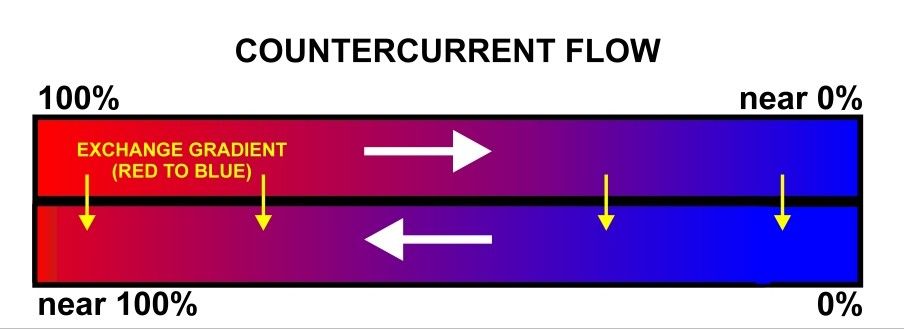
counter flow heat exchanger image from Wikimedia under CCO license
where Efficiency in this case amount of heat really transferred compared with the ideal maximum amount of heat that could be transferred.
The Co-current flow heat exchangers
In this type of heat exchangers, the fluid stream flow parallel to each other and also in the same direction. Co-current flow heat exchangers are less efficient than the counter flow heat exchangers but provide a more uniform wall temperature than the counterflow.
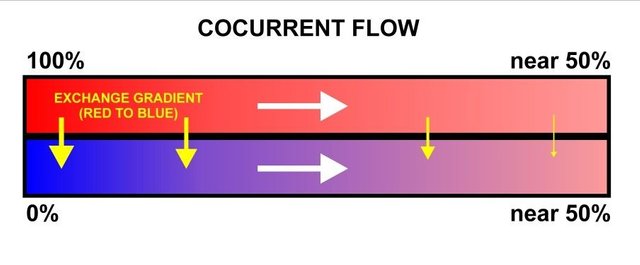
co-current flow heat exchanger image from Wikimedia under CCO license
Cross flow heat exchangers
The efficiency of the cross-flow heat exchanger is an intermediate between the countercurrent flow and the parallel flow heat exchangers. Fluids in this type of heat exchangers flow at a right angle to each other.
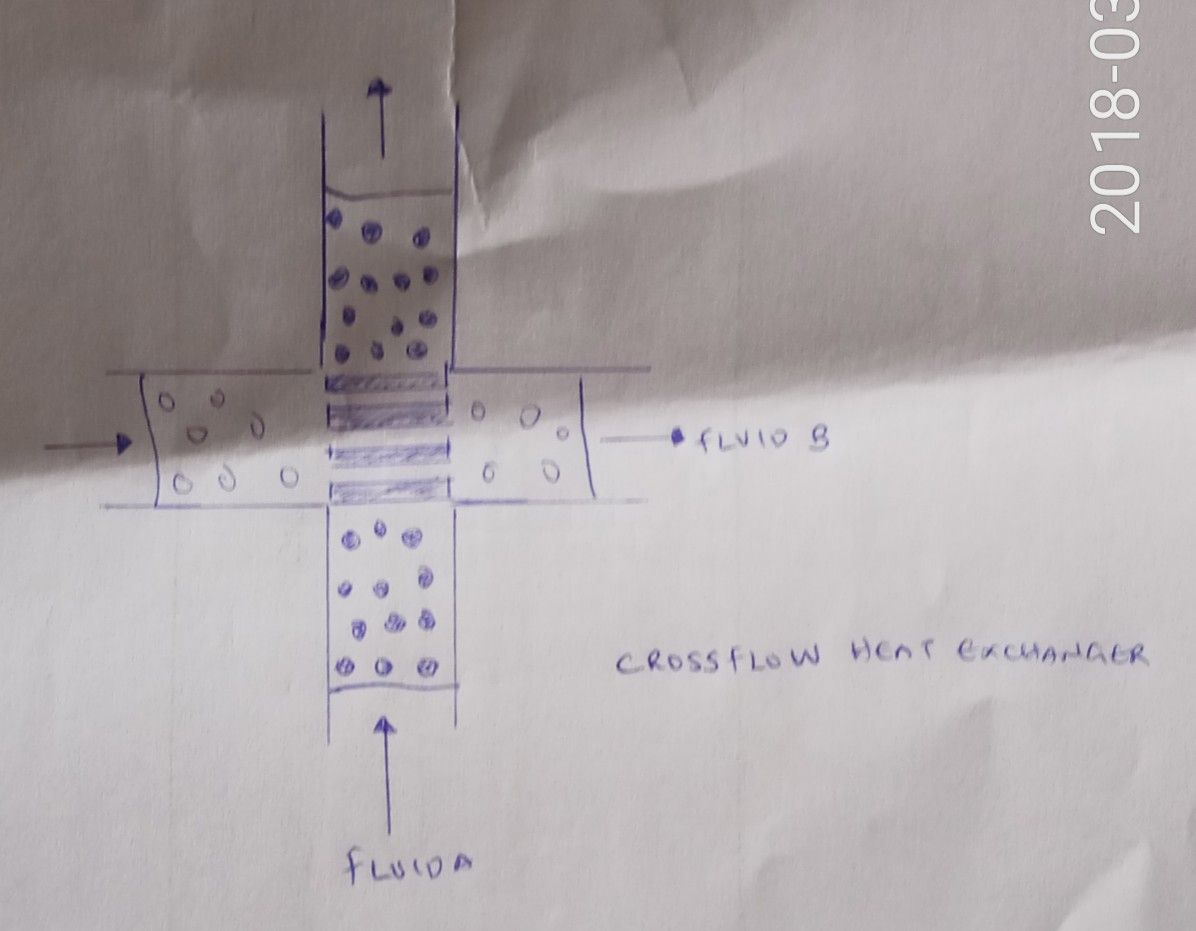
cross flow heat exchanger
Hybrid heat exchangers
Industrial heat exchangers are hybrid heat exchangers which combine crossflow, counter flow and multi-pass flow heat exchangers.
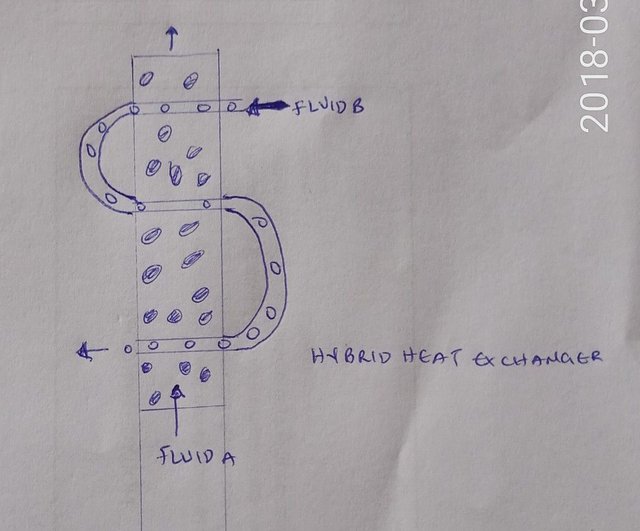
Hybrid flow heat exchanger
CLASSIFICATION OF HEAT EXCHANGER BASED ON CONSTRUCTION
The classification of heat exchangers by construction is quite wide but I will try to break it down to be much simpler. Heat exchangers are basically classified into two which are the
- Recuperative heat exchangers
- Regenerative heat exchangers
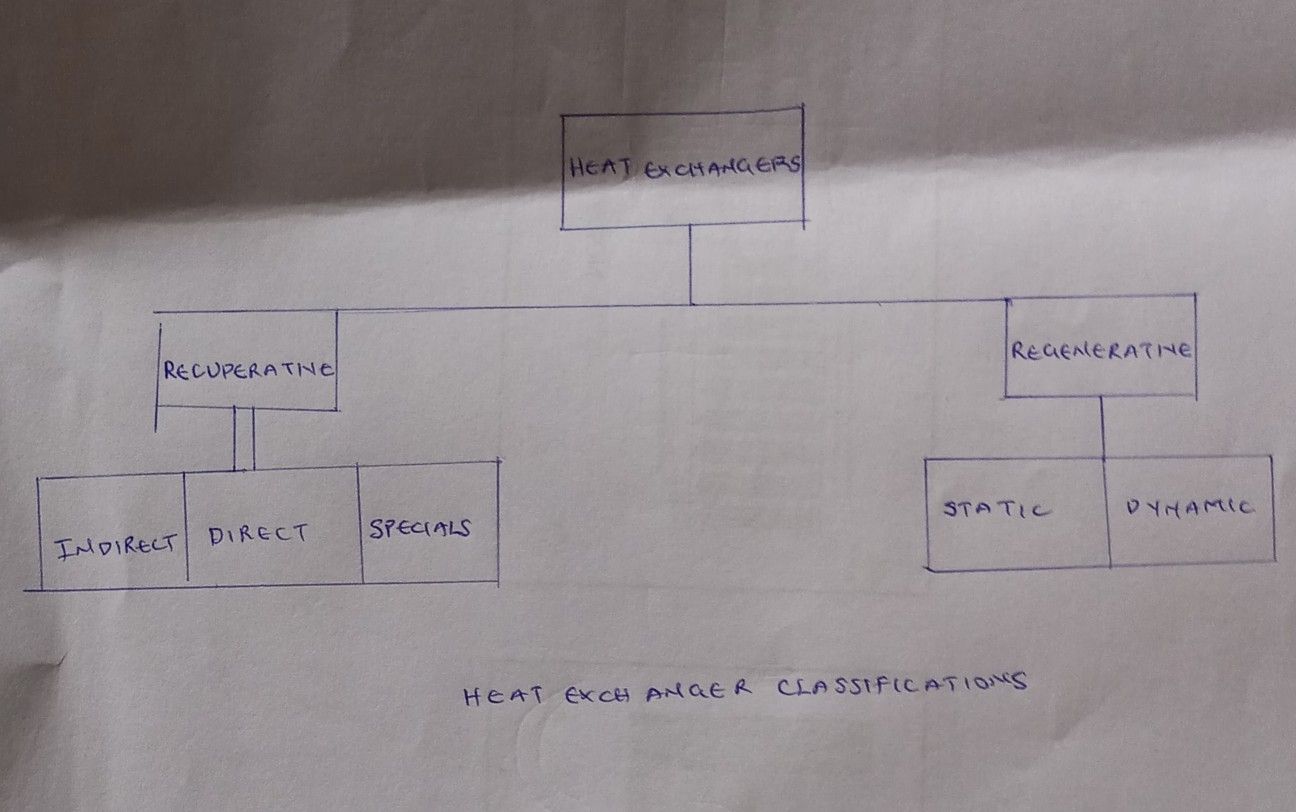
organogram of the classification
Recuperative heat exchanger
In this type of heat exchanger (i.e. Recuperative heat exchanger), there are unlike flow paths for each fluid and these fluids flow simultaneously through the exchanger exchanging heat across the wall that separates the flow paths. There are several types of regenerative heat exchangers and they are grouped into three parts which are;
- Direct contact heat exchanger
- Indirect contact heat exchanger
- Special heat exchangers
Regenerative heat exchangers
The regenerative exchangers have a single flow path which hot and cold fluids pass through alternately. This single flow path consists of a matrix which is heated when hot fluid passes through. The heat is now released to the cold fluid when it flows through this matrix. Regenerative heat exchangers are used in gas heat recovery applications in power stations.
The types of regenerative heat exchangers are dynamic and static heat exchangers
The (dynamic and static) heat exchangers are transient in operation and must be well taken care of in their design to prevent cross-contamination of both the hot and cold streams. The use of regenerative heat exchangers is being improved upon to increase the efficiency and recover more low-grade heat.
APPLICATION OF HEAT EXCHANGERS
But in general, there are four types of heat exchangers used to control heat which operate on the principle of heat transfer by conduction convection and radiation which depends also on the medium. Several heat exchangers can be selected for different applications some of which include;
Shell and tube heat exchangers
These are used in fractional distillation columns, plant boilers, evaporators and some high pressure and temperature chemical processes. This is because the shell and tube heat exchanger can handle very high temperature up to 1000 degree Celsius. But the construction of this type of heat exchanger is cost as they are relatively large and consumes more space although they are much easy to operate.Plate heat exchangers
They are used in cooling in automobiles and also refrigeration systems, they applied in low temperature and pressure with temperatures not exceeding 200 degrees Celsius and 20 bars. These plate heat exchangers are easy to install with a high heat transfer coefficient.Tubular heat exchangers
These are used for jacket pipelines which mean hot fluid is allowed to pass through the inner tube while the cold fluid passes through the space between the inner and outer pipes. These are also adopted in car radiators, heating system, and air conditions both the concurrent and countercurrent flows are easily controlled by the tubular heat exchanger.Air cooled heat exchangers
These are the kind of heat exchangers installed in your electric equipment’s like your inverter, laptops and even used on the car radiator to cool the radiator. They are used in areas or corners where it is tight or not easy to reach.
There are several applications for several types and design of heat exchangers depending on their design. The food industry, pharmaceutical worlds, chemical industries, petrochemical, oil and gas, refrigeration and even paper industries all use one form of heat exchanger or another.
CONCLUSION
The heat exchangers are life-saving devices which operate on several thermodynamic principles and transfer heat from one fluid to another. There are several types of heat exchangers which are designed for different functions depending on where they are needed.
I was able to learn so much about heat exchangers and their wonderful impact these devices provide to the environment today. I hope you enjoyed reading.
Let me know what you feel in the comment box. wink.
REFERENCES
For further reading, please visit any of these books or links
- thermopedia
- heat-exchanger-applications
- Heat-Exchanger
- Wiki exchanger
- how-heat-exchangers-work
- what-is-a-heat-exchanger
- heat_exchanger_applications.html
- 10.1615/AtoZ.h.heat_exchangers a book on heat exchangers
If you write STEM (Science, Technology, Engineering, and Mathematics) related posts, consider joining #steemSTEM on steemit chat or discord here. If you are from Nigeria, you may want to include the #stemng tag in your post. You can visit this blog by @stemng for more details. You can also check this blog post by @steemstem here and this guidelines here for help on how to be a member of @steemstem. Please also check this blog post from @steemstem on proper use of images devoid of copyright issues here.

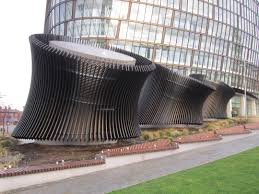
Congratulations @adetola! You have completed some achievement on Steemit and have been rewarded with new badge(s) :
Click on any badge to view your own Board of Honor on SteemitBoard.
To support your work, I also upvoted your post!
For more information about SteemitBoard, click here
If you no longer want to receive notifications, reply to this comment with the word
STOPWow, and yet another reminder of my undergraduate days.
The principle of operation of the heat exchanger is quite simple, heat flows from hotter to colder regions.
Nice write up sir
I am glad to have reminded you sir!.. Thank you for taking time to read.
I really enjoyed being reminded of my Internship, I worked with a lot of heat exchanger s, especially the tubular types, many of the machines we fabricated simply wouldn't operate without a well designed heat exchanger.
Well.. The heat exchangers are very interesting. I am glad to have brought back memories.
Being A SteemStem Member
Thank you